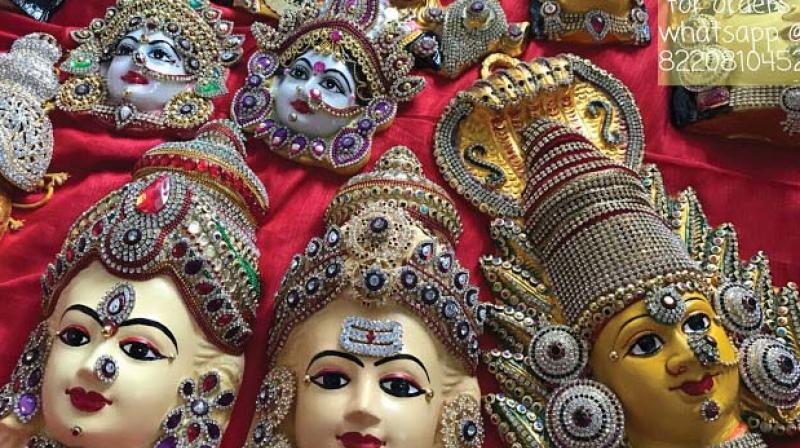Unmasked: When the Goddess of Bounty makes her arrival
It is the month of festivals, ceremonies and celebrations, when deities are venerated and marriages solemnised.

Bengaluru: It has been nearly a decade and every year, Lawrence makes his timely return to his spot on Mysuru Road, his collection of colourful, ornate Lakshmi Mukhavadas ready for the month of celebration ahead. This is also the start of Shravana Maasa, one of the most auspicious in the Hindu calendar.
It is the month of festivals, ceremonies and celebrations, when deities are venerated and marriages solemnised. On Vara Mahalakshmi, when the devout make their invocations to the Goddess of Wealth, masks depicting the deity's face make their customary appearance in city homes.
 People shopping on the eve of Varamahalakshmi festival at KR Market, in Bengaluru on Thursday.
People shopping on the eve of Varamahalakshmi festival at KR Market, in Bengaluru on Thursday.
The fifth month of the lunar cycle, Vara Mahalakshmi is celebrated on the first Friday of Shravana Maasa. The beautiful Lakshmi Mata masks are made from poly fibre and adorned with stones, garlands, kundans and jardosi lace. Artisans from Puducherry are behind their creation, along with craftsmen from some other parts of Tamil Nadu, says Lawrence, who is an artist and idol seller.
Varalakshmi translates into 'boon-granting' goddess, says Lawrence, who is remarkably well-versed in the traditions and beliefs that underlie the festival. Worshipping the Goddess Lakshmi on this day is equivalent to worshipping Ashtalakshmi, the eight goddesses of Wealth, Earth, Learning, Love, Fame, Peace, Pleasure and Strength.
"Earlier, people would do poojas for the kalasa," says Lawrence, whose has been associated with the festival for long and has seen it change, taking on more consumerist undertones over time. "Now, people are ready to spend anywhere between Rs 100 to Rs 2000 for a single mask," say Lawrence, adding, "The rates vary according to the decorated stonework on each mask." The masks were also no larger than eight inches, he recalls, while today, they vary between nine and seven inches in width.
Chitra Rao, a pottery maker, calls it a "trend," saying, "I follow the old practice of worshipping the kalasa." Still the Lakshmi Mukhavada has found its spot in the Hindu household, with the womenfolk making elaborate drapes to give the masks a more feminine touch. "It's easier to drape a saree around a person than a mask. It's quite a unique craft, one that you see in temples and even a small mistake can ruin the whole thing. Now, it's become a style statement, with people vying with each other over who has the most beautifully decorated Mukhavada!"

